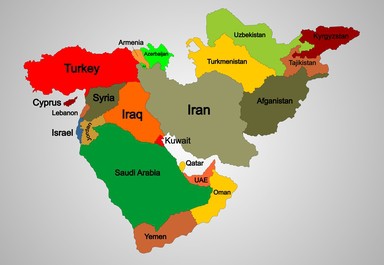The Middle East Has the Least Dogs

Middle Eastern Countries have the least amount of dogs per head of human population. This is likely due to religious beliefs. Indonesia, which is also Islamic, joins the Middle Eastern countries in low numbers of dog ownership.
Saudi Arabia, Egypt, and Indonesia all have less than two dogs per 1000 people. That is the lowest of the majority of countries.
Interestingly,although those countries have the lowest number of dogs, they have the highest number of big breeds for the dogs they have. It’s possible this is because those dogs are used as working dogs and guard dogs, rather than as pets.
Of all the dogs in Saudi Arabia, 70 percent of them are large breeds.
While Asian countries also have low levels of dog ownership compared to most western nations, the Philippines bucks that trend. There is one dog for every 8 people, which is six times more than the much larger country of China.

The Maldives is made up of approximately 1190 islands. It’s been stated that there isn’t a single dog on any of the 200 inhabited islands.
About 10 dogs are used by the police department, but they are kept out of sight unless used in operations.
Manono, a small island that is part of Samoa has prohibited dogs. This is in contrast to the main island of Samoa, where dogs are plentiful and often seen running around the streets. Some people consider Samoa to have too many dogs for the size of the island.
Some countries find it difficult to ascertain the numbers of dogs due to the sheer number of stray dogs.
Russia has a very large number of strays that are hard to quantify. There are so many stray dogs that they are becoming an acceptable part of the Russian landscape.
In Europe, the country with the least amount of dogs is Estonia. Dog numbers in some European countries have increased a lot for a few years. Between 2010 and 2019, they increased by 11 million.
Germany has the most dogs in Europe, with over 10 million.
At one point in its history, owning a dog in Reykjavik in Iceland was illegal, and the effects of decades without dogs are still felt to this day. Although you can own a dog there now, they have very stringent rules around dog ownership, such as around vaccination, microchipping, and leash laws.
Cat ownership is much higher in Reykjavik than most places, and it’s considered this is a carry-over effect of the times no dogs were allowed.
Some countries are not dog friendly, or they don’t have the same levels of animal treatment as many of us, and it has nothing to do with religion.
When you travel with a dog, you will really get to know who is dog friendly and who isn’t. You can bet that the countries that aren’t dog friendly don’t have high levels of dog ownership.
If you are an expat and want to add to a country’s dog numbers by bringing yours with you, these countries will be very hard to do that in.
Then you have to wait 180 days before traveling there with your dog.
Expats will find it hard to take dogs into Iceland.
- Great Britain
- Northern Ireland
- Republic of Eire
- German Shepherds
- Chow-chow
- Akitas
Some Countries Don’t Consider Dogs Pets
In one African country, dogs roam freely, but aren’t considered pets. The locals use them to scare away strangers and wild animals looking for food. They don’t feed the dogs, allow them into the house, or pet them.
Although you can say countries like that have dogs, they aren’t pets in the sense pet-loving nations have pet dogs.
It depends on where in the world you live as to whether you are likely to have a dog.
In the USA, you are twice more likely to have a dog than if you live in France, and 20 times greater than if you live in India. What this tells us is, some countries may have a huge number of dogs (like all the street dogs in India), but that does not translate to pet dog ownership.
Money doesn’t seem to contribute to the likelihood of dog ownership as much as culture.
Some nations just prefer cats, and naturally have fewer dogs. You are likely to find three or four times more cats than dogs in:
Are there any countries where dogs are illegal?
Norway. In Norway it’s against the law to own certain types of breeds which are considered dangerous, It’s also illegal to breed or import these dogs. Below are the list of dogs breeds that are banned.
Why Aren’t Dogs (and Other Pets) Allowed in National Parks?
Thinking about heading to one of these countries with your dog? Think carefully. You can do it, but it’ll take some serious time and money to get all of your ducks in a row. Traveling internationally can be relatively simple (like going from the United States to Canada) or it can be almost impossible, depending on your origin country and the entry policies of your destination. It’s certainly something to keep in mind when you choose your next international destination. Here are the hardest countries to visit with a dog.
Who wouldn’t want to visit the land down under with their pup? Australia has amazing beaches, fun cities, and incredible wildlife, but unless you’re visiting from New Zealand, Norfolk Island, or Cocos Island, it’ll be tough to get there.
Australia divides countries of origin by group, so you have to find your group and follow instructions.
The good news is they have clear step-by-step instructions for anyone hoping to enter the country with a pup, the bad news is your pet will definitely require quarantine.
There’s also a list of requirements, like tests and treatments, to get done. Going through the entire process is time consuming and expensive, plus you’ll be separated from your dog for at least 10 days, if not more. Ouch.
If you’re coming from a designated region (Iceland, Australia, New Zealand, Fiji Islands, Hawaii, and Guam) then you’re all good, but if you’re coming from elsewhere you’ll have to do some serious planning.
Your dog will need not one, but two rabies vaccinations, administered at least 30 days apart. After, they’ll need a blood sample drawn at an approved laboratory.
On top of this, you’ll have to wait 180 days before entering Japan! The entire process, from start to finish, will take well over six months.
Fiji is a paradise, but your desire to visit with your pup will need to outweigh all of the hurdles put in your way.
Dogs coming from Australia and New Zealand must be quarantined for seven days, and those arriving from other countries must complete a mandatory minimal quarantine period of 30 days!
That’s not all. Dogs coming from all countries, except Australia and New Zealand, are subject to a Rabies Monitoring and Surveillance Policy, meaning they’ll need to be inspected three more times post-quarantine. It takes one full year! Bummer.
Don’t plan on taking your pup to Iceland unless you’ve got some serious dough saved up.
My dreams of frolicking with my dogs and some Icelandic ponies after climbing a glacier were doomed when I realized how much money and time it would take.
All imported dogs are required to stay in quarantine for four weeks, and they can only be admitted during a designated period of three days out of every month!
There is only one viable quarantine location in Iceland, and there’s usually a waiting list. That doesn’t give you much wiggle room for your arrival, so forget about being flexible.
You’ll also need a bunch of tests administered to your pooch before arriving, within a certain amount of days. What a headache!
Planning to take your pup to Jamaica? It might be harder than you think. Only pets from Great Britain, Northern Ireland or the Republic of Eire are allowed entry into Jamaica. That’s just three locations in the whole world.
You can only enter India with your pup as baggage if you’re transferring your residence to India after two years of continuous stay abroad.
That’s great if you’re moving to India, but not so great if you’re just going for a visit. This limits the ability to bring your pooch to a very specific category that most travelers don’t fall into.
They’ve prohibited 12 breeds – as well as any mixes derived from those breeds – from entering the country.
There is an application you can fill out to contest this, but it includes strict requirements and requires a property inspection.